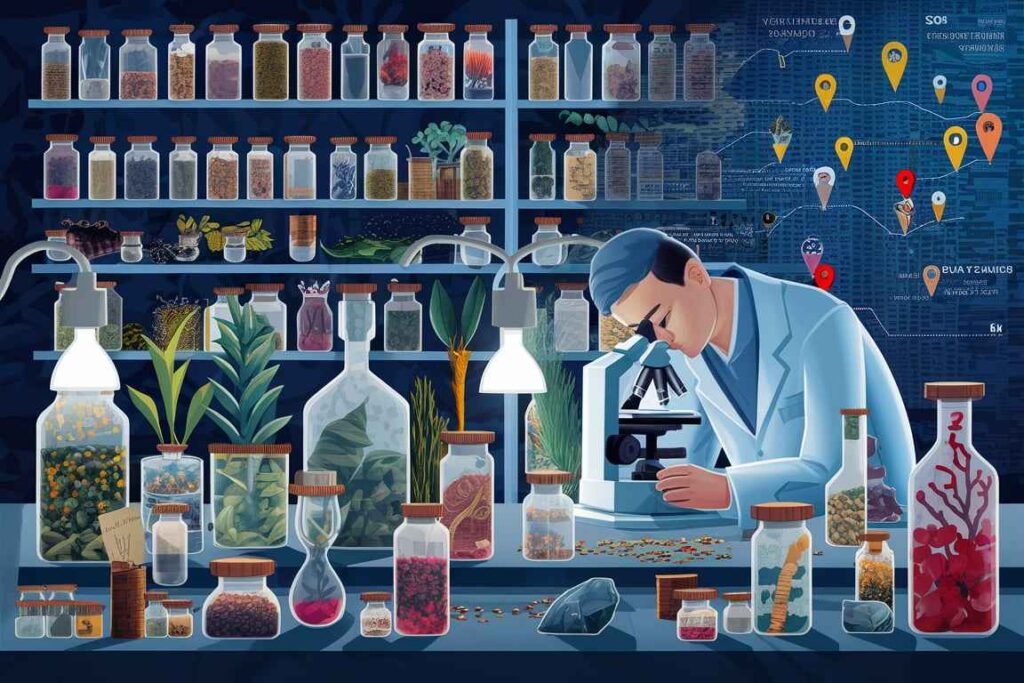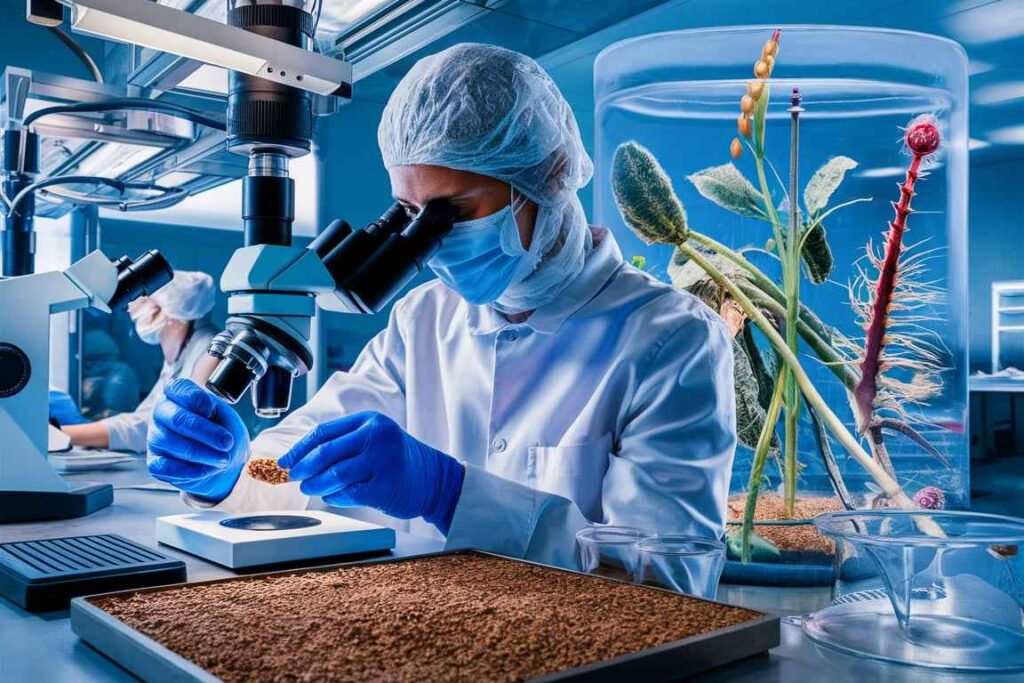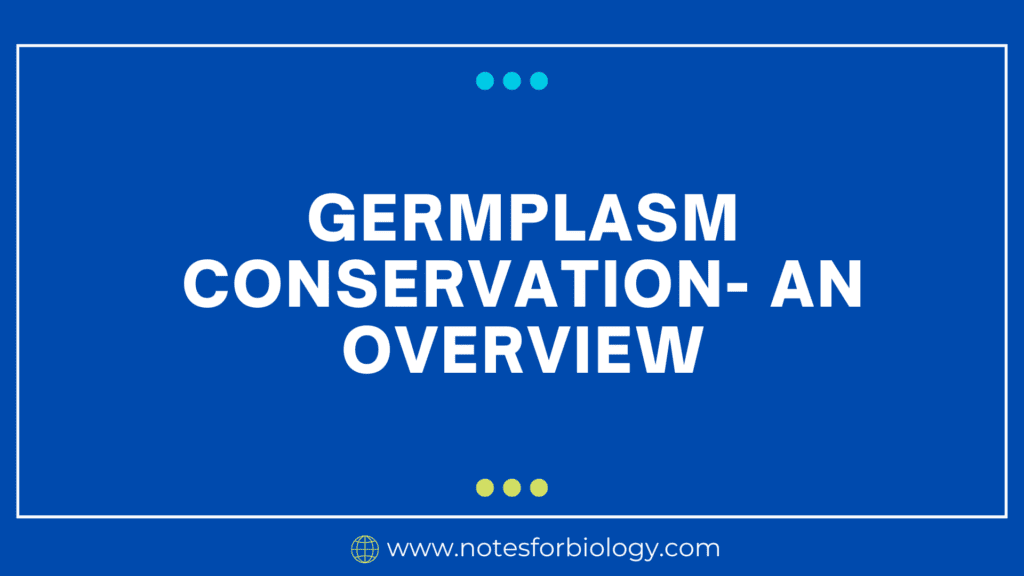Germplasm conservation is vital to guaranteeing food security, protecting biodiversity, and promoting sustainable agriculture. The conservation of genetic resources serves as the foundation for breeding programs, research, and the production of robust and productive crops and animals. Despite tremendous progress made through worldwide initiatives and enhanced conservation approaches, obstacles like as genetic loss, budgetary limits, and climate change must be addressed. Effective legislation, international cooperation, and ongoing investments in germplasm conservation are critical to preserving our genetic heritage for future generations.
Table of Contents
Germplasm Conservation
A vital component of forestry, agriculture, and biodiversity conservation is germplasm conservation. It entails the protection of biodiversity, sustainable agriculture, and food security by safeguarding the genetic resources of plants and animals. Pollen, seeds, tissue cultures, and other genetic elements required for plant and animal breeding are all considered to be parts of germplasm.

Importance of Germplasm Conservation
1. Food Security:
To guarantee a steady supply of food, genetic variety in cattle and crops must be preserved.
Breeding novel cultivars that are resistant to diseases, pests, and shifting weather patterns is made easier by genetic variety.
2. Protecting Biodiversity:
By preserving the genetic makeup of uncommon and endangered species, germplasm conservation contributes to the preservation of biodiversity.
It promotes resilience and stability in ecosystems.
3. Agriculture Enhancement:
The foundation for breeding initiatives that aim to increase crop yields, nutritional quality, and resilience to biotic and abiotic challenges is provided by germplasm conservation.
It makes it possible to create new animal and plant breeds.
4. The Cultural Heritage
For their cultural traditions and means of subsistence, many indigenous tribes rely on traditional breeds of animals and plants.
This cultural legacy will continue to exist thanks to germplasm conservation.
5. Development and Research:
Resources for scientific study in genetics, biotechnology, and breeding can be found in germplasm banks.
They encourage the search for novel genes and features that can be applied to agricultural and animal breeding initiatives.
Techniques for Conserving Germplasm
There are two main categories for germplasm conservation: i
1. In situ Techniques

Preserving genetic resources in their native environments is known as “in situ conservation.”
Reserved Regions:
It establishing protected areas, wildlife reserves, and national parks in order to preserve wild animals and their environments.
These places offer a healthy, natural habitat for various species to develop and flourish.
Agricultural Conservation:
On their fields, farmers continue to raise cattle and grow crops according to custom.
It aids in the preservation of traditional knowledge and agricultural biodiversity.
Residential Gardens:
small-scale conservation in home gardens with a variety of plant types.
These flower gardens serve as genetic diversity repositories.
2. Ex situ Techniques

Preserving genetic resources outside of their native environments is known as “ex situ conservation.”
Banks of Seed:
To keep seeds viable for extended periods of time, they are gathered, dried, and kept in cold storage.
Crop diversity preservation depends on seed banks like the Svalbard Global Seed Vault.
Gene repositories
Seeds, pollen, and tissue cultures are among the genetic materials kept in controlled settings in gene banks.
They make it easier to access genetic resources and promote long-term conservation.
Gene Banks on the Field
Gardens and fields are used to cultivate and preserve live plants for future use.
For species with recalcitrant or nonviable seeds, this technique is applied.
Cryopreservation:
Liquid nitrogen is used to maintain genetic material at very low temperatures.
Seeds, embryos, and tissues that are vulnerable to alternative storage techniques can be preserved via cryopreservation.
Intravitreal Preservation:
Plant tissues or cells are cultivated in carefully monitored lab environments.
For species that are hard to conserve via seeds or field gene banks, this technique is employed.
Challenges in Germplasm Conservation
1. Genetic Erosion:
Genetic diversity lost as a result of altered farming methods, overexploitation, and habitat degradation.
Genetic resources are also seriously threatened by climate change.
2. Financial and Technical Restrictions:
Both a substantial financial commitment and specialized knowledge are needed to establish and manage germplasm banks.
Many nations lack the funding necessary for efficient germplasm conservation, particularly those in developing nations.
3. Legislation and policy:
Insufficient guidelines and rules concerning the preservation and application of genetic resources.
Access to germplasm may be hampered by problems with benefit-sharing and intellectual property rights.
4. Records and Description:
Absence of thorough information about the genetic diversity of germplasm that has been conserved.
For breeding initiatives to be used effectively, proper characterisation and documentation are necessary.
5. Limitations of Ex Situ Conservation:
Ex situ conservation is difficult for many species because their seeds cannot withstand drying or freezing.
Maintaining vitality of stored germplasm requires ongoing observation and regeneration.
6. Changing climate:
The vitality of conserved germplasm can be impacted by modified growth circumstances.
Adaptive conservation strategies are required to deal with the changing climate.
Global Programs for Conserving Germplasm
1. Svalbard Global Seed Vault:
- Situated in Norway, the Svalbard Global Seed Vault functions as an international repository for seed samples originating from all over the world.
- It guarantees the maintenance of genetic variety and acts as a safe backup for other seed banks.
2. The International Treaty on Plant Genetic Resources for Food and Agriculture, or ITPGRFA:
The agreement encourages the preservation and responsible use of plant genetic resources.
It promotes equitable benefit-sharing and the exchange of germplasm.
3. The Crop Trust (Global Crop Diversity Trust):
a multinational group dedicated to preserving agricultural diversity and making it available for food security.
The Crop Trust provides global assistance for gene banks and other conservation activities.
4. The Consultative Group for International Agricultural Research (CGIAR):
a worldwide collaboration that carries out studies for future food security.
CGIAR centers carry out research on improving crops and animals as well as maintaining substantial collections of germplasm.
5. The Convention on Biological Diversity (CBD):
A global agreement with the goals of protecting biological variety, encouraging sustainable use, and guaranteeing equitable benefit sharing.
The CBD backs global and national initiatives to conserve germplasm.
6. Global System on Plant Genetic Resources of the FAO:
Global initiatives to safeguard plant genetic resources are coordinated by the Food and Agriculture Organization (FAO).
FAO offers member nations capacity building, policy guidance, and technical help.
Frequently Asked Question
What is Germplasm Conservation ?
A vital component of forestry, agriculture, and biodiversity conservation is germplasm conservation. It entails the protection of biodiversity, sustainable agriculture, and food security by safeguarding the genetic resources of plants and animals.
What are the Challenges in Germplasm Conservation ?
The Challenges in Germplasm Conservation are
1. Genetic Erosion
2. Financial and Technical Restrictions
3. Legislation and policy
4. Records and Description
5. Limitations of Ex Situ Conservation
Related Article
Cryopreservation: Principle, Process, limitations and precautions

